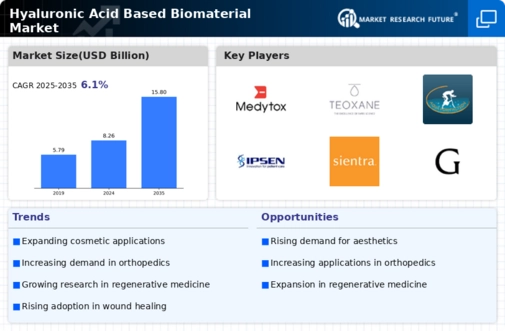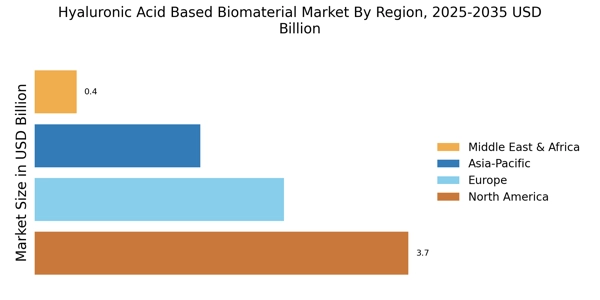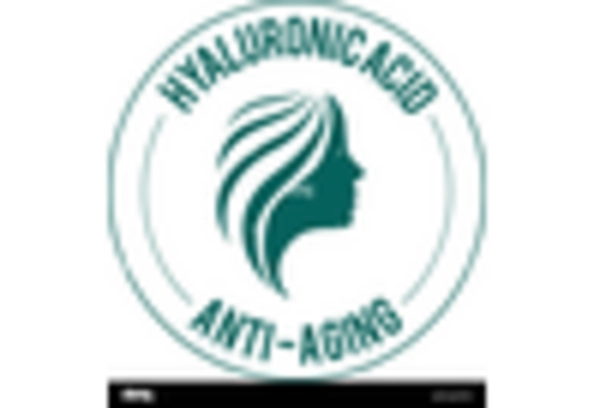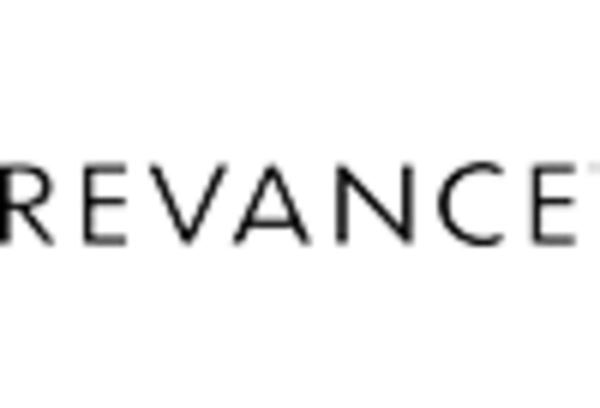Regulatory Support and Innovation
The Hyaluronic Acid Based Biomaterial Market benefits from regulatory support and innovation, which are crucial for its growth. Regulatory bodies are increasingly recognizing the therapeutic potential of hyaluronic acid, leading to streamlined approval processes for new products. This supportive environment encourages companies to invest in research and development, fostering innovation in hyaluronic acid applications. Recent data suggests that the number of approved hyaluronic acid-based products has increased significantly, reflecting a growing confidence in their safety and efficacy. As the market continues to evolve, the combination of regulatory support and innovative product development is likely to drive the expansion of the hyaluronic acid biomaterial sector, creating new opportunities for manufacturers and healthcare providers.
Advancements in Drug Delivery Systems
The Hyaluronic Acid Based Biomaterial Market is experiencing significant advancements in drug delivery systems, which are enhancing the efficacy of therapeutic agents. Hyaluronic acid's biocompatibility and ability to form hydrogels make it an ideal candidate for controlled drug release applications. Recent studies indicate that formulations incorporating hyaluronic acid can improve the bioavailability of drugs, particularly in cancer therapies and chronic disease management. The market for drug delivery systems utilizing hyaluronic acid is expected to grow at a CAGR of around 10% in the coming years. This growth is fueled by the increasing need for targeted therapies and the rising prevalence of chronic diseases. As researchers continue to explore innovative applications of hyaluronic acid in drug delivery, the market is poised for substantial expansion.
Growing Demand for Cosmetic Applications
The Hyaluronic Acid Based Biomaterial Market is experiencing a surge in demand for cosmetic applications, particularly in dermal fillers and skin rejuvenation products. The increasing consumer awareness regarding aesthetic enhancements and the desire for youthful appearances are driving this trend. Recent market analyses indicate that the cosmetic segment is projected to grow at a CAGR of around 9% in the next few years. This growth is attributed to the rising popularity of non-surgical procedures and the effectiveness of hyaluronic acid in providing immediate results. As more individuals seek minimally invasive cosmetic treatments, the demand for hyaluronic acid-based products is likely to escalate, further solidifying its position in the beauty and wellness industry.
Rising Interest in Regenerative Medicine
The Hyaluronic Acid Based Biomaterial Market is significantly influenced by the rising interest in regenerative medicine. Hyaluronic acid plays a crucial role in tissue engineering and regenerative therapies due to its natural properties that promote cell proliferation and tissue repair. The market is witnessing a surge in research and development activities aimed at harnessing hyaluronic acid for applications in skin regeneration, cartilage repair, and wound healing. Recent estimates suggest that the regenerative medicine sector is expected to grow at a CAGR of approximately 12% over the next five years, driven by advancements in biotechnology and an increasing focus on personalized medicine. This trend indicates a promising future for hyaluronic acid-based biomaterials as they become integral components in innovative therapeutic strategies.
Increasing Adoption in Orthopedic Applications
The Hyaluronic Acid Based Biomaterial Market is witnessing a notable increase in the adoption of hyaluronic acid in orthopedic applications. This trend is primarily driven by the growing prevalence of osteoarthritis and other joint-related disorders. Hyaluronic acid is utilized in viscosupplementation therapies, which aim to alleviate pain and improve joint function. According to recent data, the orthopedic segment is projected to account for a substantial share of the market, with a compound annual growth rate (CAGR) of approximately 8% over the next few years. This growth is indicative of the rising acceptance of minimally invasive procedures and the effectiveness of hyaluronic acid in enhancing patient outcomes. As healthcare providers increasingly recognize the benefits of these biomaterials, the demand for hyaluronic acid in orthopedic applications is likely to continue its upward trajectory.


















Leave a Comment